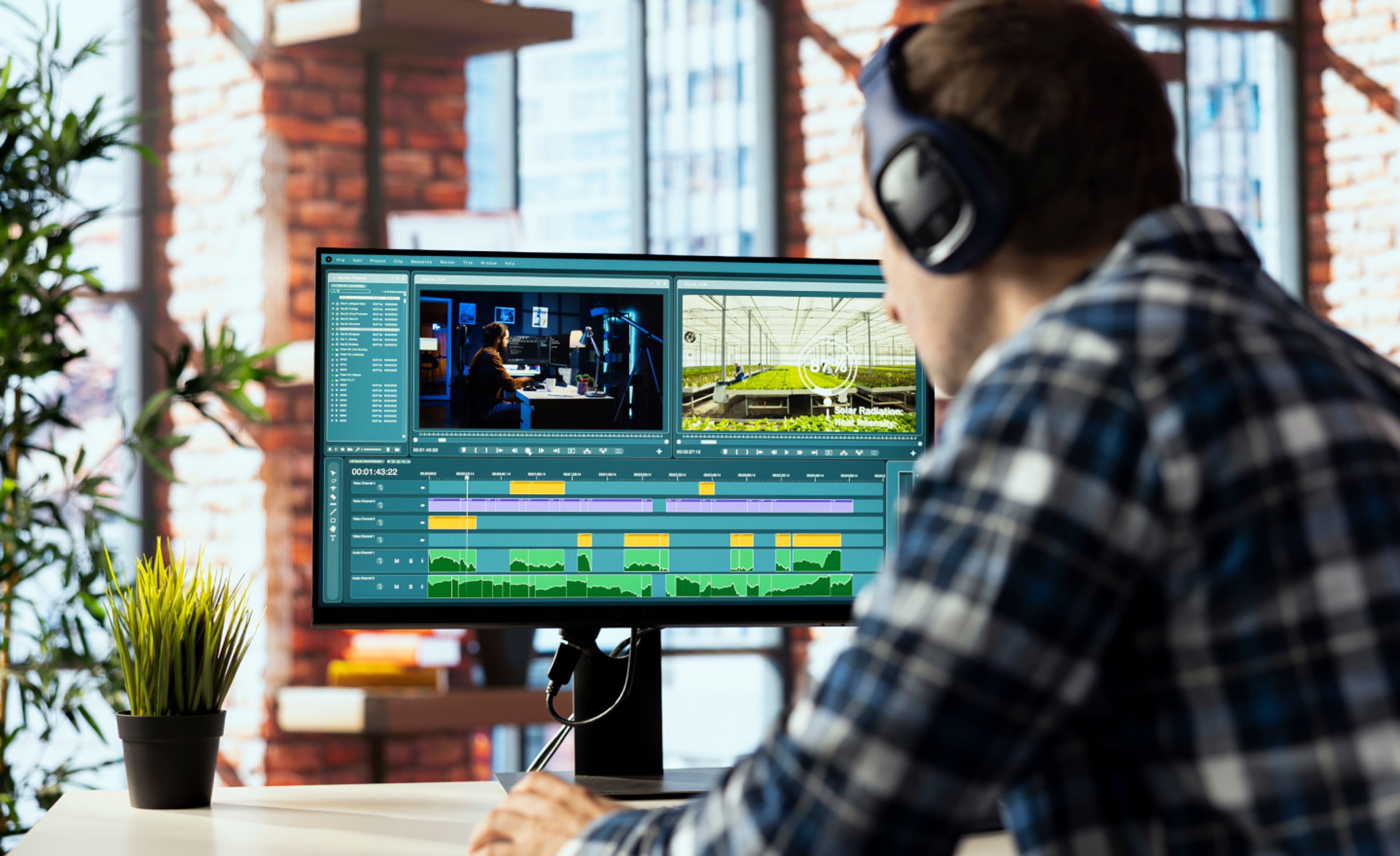In the field
Remote collaboration fuels Oscar-winning success for the team behind 'The Boy, The Mole, The Fox and The Horse'
April 2024
6 mins

Table of contents
Your files, faster.
Access any file instantly, anywhere. Collaborate in real-time from one always-up-to-date, secure cloud filespace.
It took more than 120 artists across 20 countries to bring Charlie Mackesy’s beloved book to the screen. The result? The Boy, the Mole, the Fox and the Horse, an Oscar-winning animated short that proves remote collaboration can deliver world-class storytelling.
The Christmas classic tells the tale of a boy (voiced by Jude Coward Nicoll), a mole (Tom Hollander), a fox (Idris Elba) and a horse (Gabriel Byrne) on a journey to find a home. Hand-drawn animation brings Mackesy’s signature illustrations to life in a way that comforts audiences while staying true to the spirit of the book.
Produced during the pandemic, the film came together over 16 months of remote teamwork. More than 120 creatives from clean-up artists to editors worked seamlessly across continents to make it happen.
We spoke with Setareh Erfan, Clean Animation Supervisor and Daniel Budin, Editor about the creative journey and how the team overcame the challenges of fully remote animation production.
Crafting an Oscar-winning masterpiece
Apple Original Films earned its first Academy Award for Best Animated Short with The Boy, the Mole, the Fox and the Horse — a heartwarming story that blends kindness, friendship, courage and hope.
The film remained faithful to Charlie Mackesy’s bestselling book, which has sold more than 8 million copies worldwide since 2019, but the challenge was clear: how do you bring still illustrations to life without losing their quiet hand-drawn magic?
The answer lay in a collaborative team effort. Working directly with Mackesy, animators and editors transformed delicate sketches into moving images that carried the same warmth and intimacy as the book. This careful translation from page to screen was pivotal to the film’s success.
Remote collaboration against all odds
The production unfolded during the height of the pandemic with artists spread across the globe. NoneMore Productions — formed specifically to adapt the book for screen — had to create a workflow that kept 120+ creatives aligned despite distance, time zones and limited infrastructure.
The process mirrored a traditional animation pipeline: storyboards, layout, blocking, animation, clean-up, ink and compositing. But unlike most pipelines, this one depended entirely on remote collaboration and cloud-based tools to keep every frame moving forward.
We managed the whole production in the cloud, allowing artists to work directly from their workstations and making it easy for team members to share their work with the full team regardless of the creative application or platform they were using.
Daniel Budin,Editor

“With a dispersed team, we managed various tasks from different corners of the globe. Storyboards and layouts took shape in Adobe Photoshop, while TVPaint was our animation hub,” shares Daniel Budin, the film’s Editor.
“Compositions materialized in Nuke and After Effects, and we turned to Avid Media Composer and Adobe Premiere for editing. DaVinci Resolve was our choice for pre-conform. External expertise was tapped for sound mixing and grading.”
Each stage of the team’s work came together in Avid Media Composer, and all footage and media assets were stored in a shared LucidLink filespace for easy access. This enabled seamless cross-collaboration across the project’s animation, sound and design aspects while working remotely.

Having a geographically dispersed team was challenging, but LucidLink became the team's central collaboration space where everything came together.
“As soon as LucidLink was set up, artists could work their way. The technical aspects behind the solution remained hidden in the background, never interfering with their workflow,” Budin reveals.
“We managed the whole production in the cloud, allowing artists to work directly from their workstations and making it easy for team members to share their work with the full team regardless of the creative application or platform they were using.”
To keep things running smoothly, each department was led by a Head of Department (HOD) who delegated workloads. Budin explained that the team held daily and weekly feedback sessions for the various stages of the project, along with reviews with each HOD and the director
From storybook to the big screen
Adapting the book into animation meant preserving the charm of his original illustrations while translating them into movement and performance.
Clean Animation Supervisor Setareh Erfan and the team worked closely with Mackesy to ensure the designs stayed true to his hand-drawn style — while making key creative decisions that would allow the characters to live and breathe on screen.
Character development

“The book’s author, Charlie Mackesy, was heavily involved in ensuring that the designs adapted for animation were true to his style,” explains Erfan.
“The designs had to be adjusted a bit. For instance, the Boy’s face was never shown in the book, so this was new territory for everyone.”

Clean-up animations

Erfan described the process: “Once we solidified the designs and had character turnarounds (model sheets), our 2D animators embarked on rough pencil drawings using TVPaint. They concentrated on perfecting character movements and performances, always in sync with the storyboard and under the guidance of co-directors Peter Baynton and Charlie Mackesy.”

Following approval of the rough animation, the shot could move onto the ink stage. “In this stage, our clean animation artists would essentially re-draw the rough animation using a specific custom-made ink brush in TVPaint.”
Throughout the process, the team also had the critical job of maintaining character consistency, ensuring a visually cohesive film.
The art of sound and voice-overs in the film
With the film's team and voice actors spread across the globe, the sound production and editing processes also had to adapt to remote collaboration.

“Voiceovers were recorded in various studios across the UK, and dialogue was placed in Media Composer,” says Budin.
"This was a very important step as they served as the foundation for the lip-synch animations and, to some degree, for the acting.” Additionally, SFX and the orchestral score for the film were done out of house.
Building an effective remote dynamic
Given our team was spread across different countries, seamless collaboration was vital, and witnessing this dynamic come to life was truly exceptional.
Daniel Budin,Editor
Budin shares one of the biggest rewards of working with global teams: seeing the story take shape in the edit.
“To keep all teams in sync and ensure we hit our goals, we held numerous feedback and review sessions. Given our team was spread across different countries, seamless collaboration was vital, and witnessing this dynamic come to life was truly exceptional.”

“Once a week, we’d hold team meetings to share and celebrate our accomplishments, like approved shots — sort of a celebratory show and tell! These gatherings served as a fun way to keep in touch and foster a sense of connection, despite our various locations,” adds Erfan.
“Trying to turn a very stylized, illustrative book into a half-hour 2D animated film was highly ambitious, so every time a shot would come together, it was very rewarding for the whole team.”
Tips for animators
The world of editing offers a variety of platforms, each with unique strengths. Familiarizing yourself with several of them makes you more versatile and can significantly enhance your editing process, making you more of an asset to production teams.
Daniel Budin,Editor
Stay organized
“It’s essential to keep track of various versions and to be able to locate and easily access media files," says Budin. "One effective strategy is mimicking the editing folder structure with the storage structure, especially if media files are being generated daily.”
Trust the workflow
Having a well-organized system allows for smoother narrative creation and streamlines the management across all stages of production.

Keep learning
Budin offers this advice to emerging creatives in film and animation, “If you’re an editor just starting, don’t hesitate to embrace every opportunity that helps you learn and develop your skill set."
"The world of editing offers a variety of platforms, each with unique strengths. Familiarizing yourself with several of them makes you more versatile and can significantly enhance your editing process, making you more of an asset to production teams.”
Want more tips and tricks for video production and animation? Watch this session from NAB to discover more of the magic behind the Oscar award-winning fully remote team of The Boy, the Mole, the Fox and the Horse.
Keep reading

Collaboration
In the field
Madecraft’s post-production hacks for smooth workflows
Discover how Madecraft slashes hidden costs of post-production, boosting efficiency, saving time and keeping creativity flowing.
21 November 2025, 6 mins read

Creative production
In the field
How post houses are integrating AI into modern workflows
Discover how post houses are using AI to streamline workflows, save time and boost creativity with real-world examples and practical insights.
23 October 2025, 5 mins read

In the field
Small team, big campaigns: inside Sandwich’s secrets to scaling creative
How Sandwich creates top-tier campaigns with a four-person post team — thanks to LucidLink and workflows that scale without chaos.
09 July 2025, 4 mins read
Join our newsletter
Get all our latest news and creative tips
Want the details? Read our Privacy Policy. Not loving our emails?
Unsubscribe anytime or drop us a note at support@lucidlink.com.